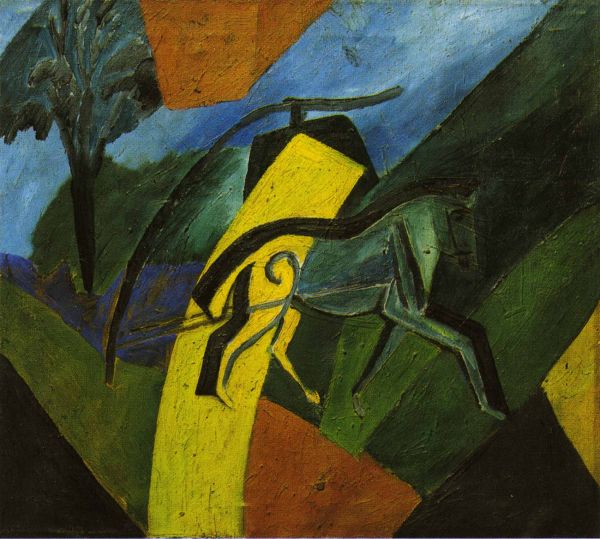|
|
Lightning Horse. 1907(?)

Burliuk David,
Oil on canvas
62 х 68
State Russian Museum
Пост.: 1933 приобр. у М.В. Матюшина (Ленинград)
Annotation
The painting Lightning Horse makes use of Cubo-Futurism’s primary innovative device: spatially shifted form. The artist divides the canvas’ surface into coloured segments that become self-sufficient, functioning independently of the work’s subject. Colour serves to link form and content, establishing a semantic thread consisting of the blue night and the yellow flash of lightning. Sharply contrasting juxtapositions serve to intensify the work’s decorative impact.
Horses were the heroes of David Burliuk’s early avant-garde period, accompanying his painting as it evolved from Neo-Primitivism to Futurism. This animal was not, however, linked to the traditional images encountered in Russian songs and ballads or the poetry of the troika. Like many of the members of the Hylæa group, Burliuk was enchanted by the free, natural and elemental nature of the animal, evoking associations with the ancient Scythian civilisation that had once inhabited the steppe country to the north of the Black Sea. Horse-Lightning was one of the works in which this experimental artist outraged the conservative public. The flat and formula-like image of the horse is excluded from the real passage of life (symbolised by a blue tree) and placed in a setting of coloured planes The whimsical, intersecting combinations of the planes evoke the illusion of depth and light-aerial vibration.
Author's Biography
Burliuk David
Burliuk, David Davidovich (1882, Semirotovshchina (Kharkov Gubernia) — 1967, Long Island, United States)
Painter, graphic artist, book illustrator, poet, author of manifestoes, critic. Studied at the Kazan School of Art (1898–1899), Odessa School of Art (1899–1901, 1910–1911), at the Königliche Akademie der Künste in Munich (1902–1903), Fernand Cormon’s studio in Paris (1904) and at the Moscow School of Painting, Sculpture and Architecture (1911–1914, expelled together with Vladimir Mayakovsky). Contributed to the exhibitions of the Union of Russian Artists (1906–1907), Fellowship of South Russian Artists (1906–1907), Exhibition of Modern Trends in Art (1908), Golden Fleece Salon (1909), Union of Youth (1910–1912), Der Blaue Reiter in Munich (1912), Der Erste Deutsche Herbstsalon (1913), Salon des Independants (1914), Knave of Diamonds (1912–1916, one of the organisers of the first exhibition in 1910), World of Art (1915, exhibitor). Lived in Japan (1920–1922) and the United States (from 1922).

